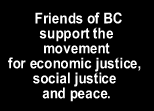
|
|||||||||||||||||||||||
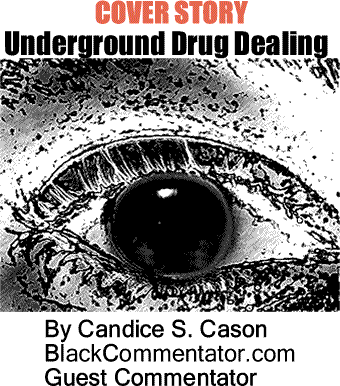
|
|||

Custom Search
|
|||
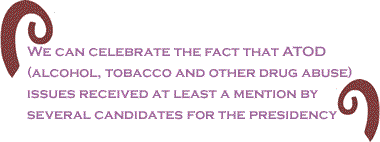 |
|||
These are samplings of headlines from more than 100 stories related to the drug economy in August 2008 editions of my local newspaper, “The Washington Post”. Because I have worked in mental health and addictions, or ATOD (alcohol, tobacco and other drug abuse prevention and treatment) for many of the last 20 years, my eye is drawn to those stories that either support the continued need for my work, or stand as testament to its shortcomings.
According to “ontheissues.org”, John McCain’s last statement or action regarding ATOD issues or policy was 18 months ago, when he expressed his appreciation of Mexican President Felipe Calderon for extraditing drug dealers to the USA. McCain’s camp probably has figured out that there is not enough consistent interest in ATOD policy in the corridors of power to make it worth the effort to say anything, though McCain’s experience as the husband of a woman in recovery would seem to provide him with food for some thought on this issue. Sarah Palin’s one statement on ATOD issues in the past year was in recognition of a reduction in Alaska highway fatalities, which she attributed to strict enforcement of laws regulating reckless driving, drunk driving and seatbelt use. Nine statements or actions regarding ATOD issues or policy were recorded by Barack Obama between August 2007 and August 2008 addressing the demand side of the ATOD equation. In keeping with the tell-all atmosphere of politics and celebrity today, three statements concerned his own tobacco use and youthful experimentation with drugs. In six other statements, he proposed the expansion of drug treatment courts; treatment, including mental health counseling and job training, for offenders with histories of substance abuse; elimination of sentencing disparities for crack and powder cocaine; consideration of needle exchange to reduce injection drug user transmission of HIV/AIDS; maintenance of the age limit for alcohol use at 21; and, he co-sponsored a bill to strengthen the Combat Methamphetamine Epidemic Act of 2005. From his days as a community organizer, Obama may harbor some memories of the power of alcohol and drug use to disrupt the work of community participants in otherwise successful organizing efforts. Joe Biden used the September 2007 Democratic Primary debate at Dartmouth College to take a strong stand against lowering the drinking age from 21 to 18, and to suggest the possible utility of laws to limit smoking in public places and limits on alcohol consumption as tools to address rising health care costs. At that time, his campaign website cited his work to increase penalties for dealing drugs near schools, his work to classify steroids as potential drugs of abuse, his work to create the Drug Czar role, and his work to establish drug courts. During the summer of 2007, he linked drug use and commission of violent crime, addressed his support for drug courts and offender diversion, and referenced sentencing disparities, which he sought to eliminate through sponsorship of legislation. His role in the establishment of a Drug Czar suggests some attention to the supply side of the ATOD equation.
So, in actuality, we can celebrate the fact that ATOD issues received at least a mention by several candidates for the presidency. And, until she withdrew from her candidacy, Hillary Clinton’s two tentative statements, one supporting diversion of non-violent offenders, and one supporting non-retroactive reduction of sentencing disparities, would have merited inclusion on the list of proposed demand side initiatives. Looking beyond the Presidential campaign, there actually is much to celebrate during National Alcohol and Other Drug Recovery Month. Since the mid-1970’s, there has been totally amazing research on addiction at the federal level, research which is now bearing fruit. Sponsored in large part by the National Institute on Drug Abuse (NIDA) and National Institute on Alcoholism and Alcohol Abuse (NIAAA), significant research has focused on neural pathways and reward systems in the human brain, and the causes, course, effects, prevention and treatment of addiction. The field application of this research has been supported through the yeoman efforts (big agenda, small dollars) of the Centers on Substance Abuse Prevention (CSAP) and Substance Abuse Treatment (CSAT), each of which has conducted or funded additional research on prevention or treatment program implementation under the aegis of the Substance Abuse and Mental Health Services Administration (SAMHSA) within the Department of Health and Human Services. SAMHSA, in a move definitely worth celebrating, in recent years submitted a comprehensive report to Congress on the Prevention and Treatment of Co-Occurring Substance Abuse Disorders and Mental Health Disorders. The predisposition of individuals with depression, bipolar disorder, schizophrenia and other very treatable mental health challenges to self-medicate with alcohol, tobacco and other drugs is undeniable.
Addiction treatment has been in the news as the recovery struggles of sports and other entertainment figures have been highlighted in the last few years, if not always in the most empathetic way, in a manner that illustrates the difficulty of the “just say no” approach. The news stories of celebrity treatment admissions and failures, combined with the life stories contained in the several important memoirs penned in recent years by individuals in recovery, serve to underscore the assertion by NIDA that “... drug addiction ... is a disease that impacts the brain and because of that, stopping drug abuse is not simply a matter of willpower”. Late last year, a decision was made by the of the US Supreme Court to allow federal judges leeway on sentencing guidelines for crack cocaine offenses, which was followed by a vote by the U.S. Sentencing Commission to allow retroactive reductions on sentence recommendations. This was a major step in the effort to eliminate sentencing disparities which, like health disparities, have a disproportionate impact on peer people, women and people of color.
This past winter, both the House and the Senate passed legislation in support of on mental health parity, legislation which would have added some insurance protections for the estimated 35 million individuals in the U.S. who grapple with mental disabilities each year. Both bills would have prohibited practices resulting in higher co-payments or lower limits on mental health service visits than are common for other illnesses. Though neither bill was signed into law, sponsors of the mental health parity bills in both the House and the Senate vowed to continue the fight for parity in the next year. The pledge of 120 Members of Congress to restore funding of the Department of Justice Drug Court Discretionary Grant Program to the $40 million level after years of funding reductions is cause for celebration at the more than 2,000 drug courts currently operating to provide a mechanism for offender enrollment in treatment, toward reducing offender recidivism and the total number of individuals incarcerated in the U.S. for non-violent offenses. In addition to monitoring offender treatment participation, most drug courts provide employment assistance, housing assistance, assistance with linkage to health services and assistance with development of life skills, including family management skills. All of this activity is great, but the time for a serious celebration of National Alcohol and Other Drug Recovery Month will occur when an elected President finds the political courage to push and work with Congress to develop, fund, implement and ensure sustainability of a comprehensive, integrated national strategy to address “the drug problem”. The strategy has to connect prevention, health care financing, rural and urban health care access, Medicaid eligibility, Early and Periodic Screening and Diagnostic Treatment (EPSDT), training of medical and counseling professionals, primary care screening and referral, emergency room screening and referral, pharmaceutical pricing, ATOD treatment, mental health treatment , liver disease prevention/reduction, heart disease prevention/reduction, cancer prevention/reduction, HIV and STD prevention/reduction, drug interdiction efforts, criminal justice initiatives, judicial policy, housing policy, educational policy, child welfare policy, alcohol taxation, tobacco taxation and other business taxation policy. The strategy will have to ensure the allocation of resources to each of these areas in accordance with not only the immediate rewards they deliver but also in accordance with their promise to reduce long-term societal costs of alcohol, tobacco and other drug use. The strategy will need to address how to fully support the efforts of States and local jurisdictions to establish prevention and treatment systems that reduce the human and business costs of drug use. Further, the strategy will need to flesh out the commitment of the U.S. to participate as a partner in the efforts of the United Nations Office of Drugs and Crime.
The “War on Drugs” and its attendant “Drug Czar” construct need to be kicked to the curb and replaced by the “Risk, Recovery and Redemption Initiative”, or something else that acknowledges the scientific progress made in ability to identify individual risk for substance abuse, to provide cost-effective treatment that is customized for the individual, and to assist the individual to find, restore or enhance their ability to contribute to their community and to society. At a point in history where the genetic and environmental vulnerabilities of any individual to drug use, abuse and addiction can be identified, a “War on Drugs” amounts to a war on individual citizens and residents of this country. An
integrated strategy needs leadership, not a Czar, for implementation.
This is the Information Age, the era of the much-heralded Global
Economy, an era in which the location of sites of drug crop cultivation
and production of drugs of abuse can be determined with some specificity.
BlackCommentator.com Guest Commentator, Candice Cason, has directed public drug treatment services for three different jurisdictions in the Greater Washington, D.C. area. Click here to contact Ms. Carson. |
|||
Any BlackCommentator.com article may be re-printed so long as it is re-printed in its entirety and full credit given to the author and www.BlackCommentator.com. If the re-print is on the Internet we additionally request a link back to the original piece on our Website. Your comments are always welcome. eMail re-print notice
If you send us an eMail message we may publish all or part of it, unless you tell us it is not for publication. You may also request that we withhold your name. Thank you very much for your readership. |
|||
| |
|||
| September 18, 2008 Issue 291 |
|
| Executive Editor: Bill Fletcher, Jr. |
| Managing Editor: Nancy Littlefield |
| Publisher: Peter Gamble |
| Est. April 5, 2002 |
Printer Friendly Version
in resizeable plain
text format or pdf
format. |
| Frequently Asked Questions |
 |

|
 |
 |
 |
| |
| |




























 September
is National Alcohol and Other Drug Recovery Month, and by mid-August
I had received no fewer than 10 mailings encouraging me to participate
in or organize celebrations marking the month. Yet, in what has
famously been labeled “the silly season” of national politics,
during which the Presidential candidates of the two major political
parties and their running mates push for and get the nod from
their fellow party-goers to pursue leadership of the USA, celebration
seems to be an overstatement of what’s called for
September
is National Alcohol and Other Drug Recovery Month, and by mid-August
I had received no fewer than 10 mailings encouraging me to participate
in or organize celebrations marking the month. Yet, in what has
famously been labeled “the silly season” of national politics,
during which the Presidential candidates of the two major political
parties and their running mates push for and get the nod from
their fellow party-goers to pursue leadership of the USA, celebration
seems to be an overstatement of what’s called for
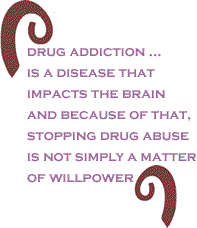 Now,
if we pretend for a moment that there really are more than two
candidates who actually will achieve serious consideration for
the Presidency of the USA, we see increased discussion of supply
side issues
Now,
if we pretend for a moment that there really are more than two
candidates who actually will achieve serious consideration for
the Presidency of the USA, we see increased discussion of supply
side issues
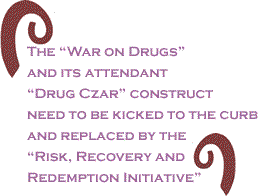 In
another positive move, in March of 2008 the Department of Veterans’
Affairs acknowledged in a statement for the Congressional Committee
on Veterans Affairs that the “incidence of substance use among
veterans tends to exceed that of comparable civilian populations.”
The statement went on to assert that substance use problems are
treatable, and delineated the intentions of the VA to substantially
expand mental health and substance abuse services for veterans
through provision of behavioral health screening services by every
VA provider, creation of new services and ramping up existing
outpatient, intensive outpatient, residential, and inpatient treatment
services. If this activity truly materializes, and is more than
just another promise broken by the VA, men and women returning
from the extreme stress of war may actually be able to access
the behavioral health services they need.
In
another positive move, in March of 2008 the Department of Veterans’
Affairs acknowledged in a statement for the Congressional Committee
on Veterans Affairs that the “incidence of substance use among
veterans tends to exceed that of comparable civilian populations.”
The statement went on to assert that substance use problems are
treatable, and delineated the intentions of the VA to substantially
expand mental health and substance abuse services for veterans
through provision of behavioral health screening services by every
VA provider, creation of new services and ramping up existing
outpatient, intensive outpatient, residential, and inpatient treatment
services. If this activity truly materializes, and is more than
just another promise broken by the VA, men and women returning
from the extreme stress of war may actually be able to access
the behavioral health services they need.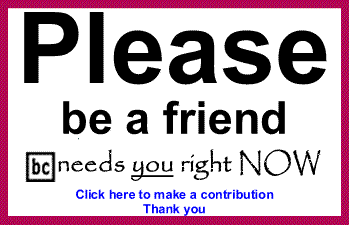
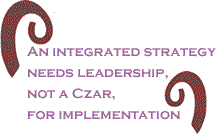 To
affect a comprehensive strategy, the next President will need
to identify assignment of oversight, demand accountability for
collaboration between the various involved agencies and, in all
likelihood, demand some consolidation of moving parts. Someone
or, better, some body or council needs to be truly empowered to
direct funding, strategic and other decision-making processes,
and to determine the appropriate balance of funding and resources
to dedicate to the demand and supply sides of the ATOD equation
To
affect a comprehensive strategy, the next President will need
to identify assignment of oversight, demand accountability for
collaboration between the various involved agencies and, in all
likelihood, demand some consolidation of moving parts. Someone
or, better, some body or council needs to be truly empowered to
direct funding, strategic and other decision-making processes,
and to determine the appropriate balance of funding and resources
to dedicate to the demand and supply sides of the ATOD equation
